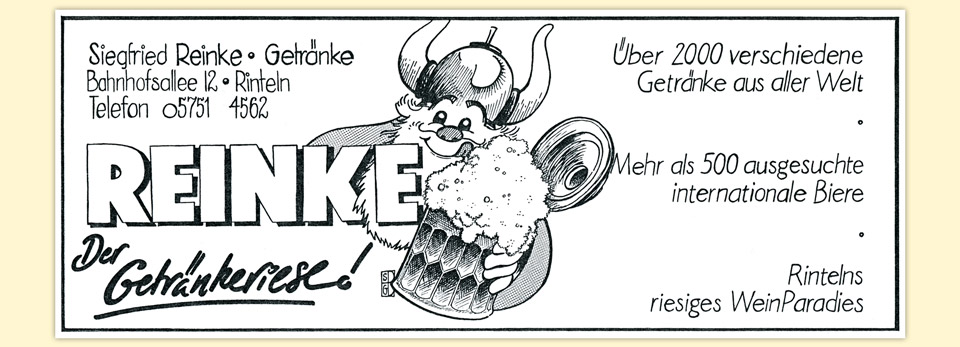ADS FROM THE OLD COUNTRY
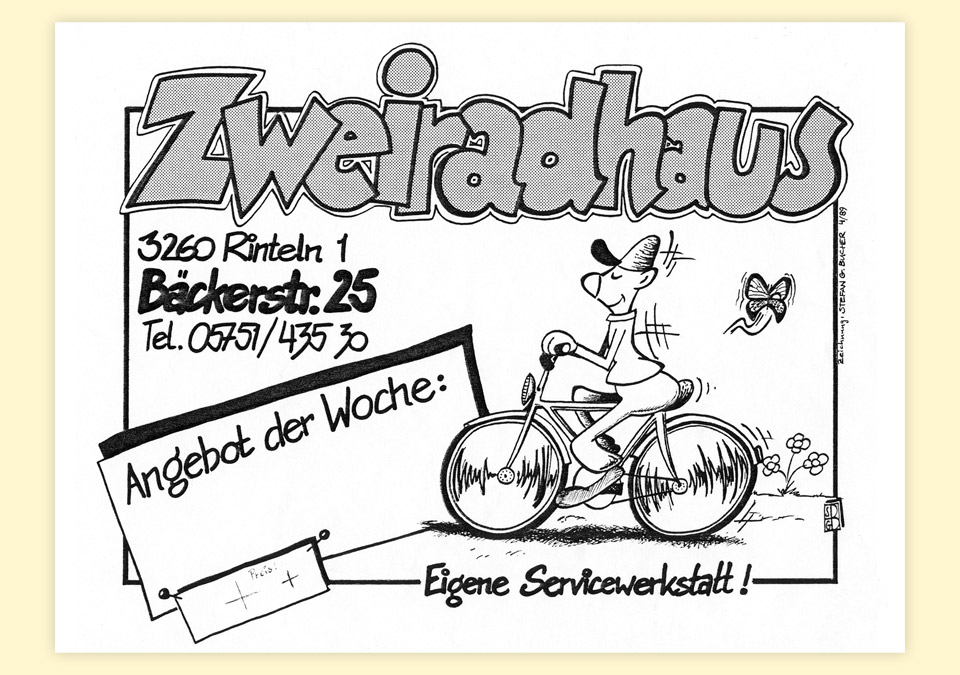
In the spring of 1989 I walked into the bicycle store down the street from our house back in Germany. I told the owner that I’d seen his ad in the paper. This made him happy. I then told him—politely—that I thought his ad was ugly, and that I had taken the liberty of making him a better one. It could be his for 50 Deutsche Mark. I was 15, and that was the highest number I could say without turning red.
Of course, a number of things happened first. I learned that drawings—my drawings—could be reproduced in print when I got my first spot in Der Donaldist four years earlier. I learned that I could get my drawings reproduced by the printer down the street when I realized that I’d outgrown photocopied holiday cards. I had also seen my drawings appear in the local paper. I had all the pieces, but I was still happily working away, illustrating things for Der Donaldist. It didn’t occur to me to make ads.
Circumstance eventually pushed me into it. In the spring of 1989 I had organized and hosted the annual congress of the Donaldists, gathering about 400 professors, judges, mathematicians, physicists, artists, and writers from all over the country. This was an honor usually reserved for cities like Berlin or Hamburg, and the fact that it happened in my little town of 20,000 people was a coup. While the event itself came off beautifully, I had a falling out with a few of the guests in the direct aftermath. These had been close friends and frequent collaborators on the magazine. I was hurt and disillusioned. I certainly didn’t want to spend my time creating illustrations or layouts for them anymore.
At the same time, I was hooked on seeing my work in print. I had to figure out another way of getting published. I’ve always been motivated by the need to fix things that hadn’t been done well, which is what drew my attention to local ads. Four years of working for Der Donaldist had taught me about working in black and white. The local paper—Der Rintelner Anzeiger—was full of horrible black and white ads. Ads by local merchants.
I chose the Zweiradhaus, because it’s where I went to get my bicycle fixed. It was a one person operation, so I knew the owner. I redrew his present ad at the same size, so all he’d have to do was hand the artwork over to the newspaper to be photographed and plated. At the functional equivalent of $50, I didn’t make the decision difficult for him. He said yes on the spot, and off we went.
Where did that adorable cyclist character come from? I’m ashamed to say that I cribbed him—copied him—from the background of a Donald Duck comic by the Italian artist Giorgio Cavazzano, who has a gorgeous, springy line that still makes me green with envy today. At least I went for quality. But I still nicked it. And I wish I hadn’t, just so I could be entirely proud of my first ad, without need for a significant footnote.
Seeing how easy it had been to sell the Zweiradhaus ad, and how cool it looked in the paper, I went looking for additional clients. Between 1989 and my leaving Germany at the end of 1993, I signed up about a dozen clients. A few of those ads are shown here. For a while I designed a new ad for a beauty salon every two weeks. I made ads for boutiques, bus tours, theater groups, and the local chapter of the social-democratic party. I reconstructed the missing letters on a blackletter alphabet for the stops on a church organ, and painted signs for Christmas goose sales. I designed a poster for a local jazz band, and ultimately landed my first major big city gig, illustrating a bear cub mascot for Glashaus Hamburg in June of 1990.
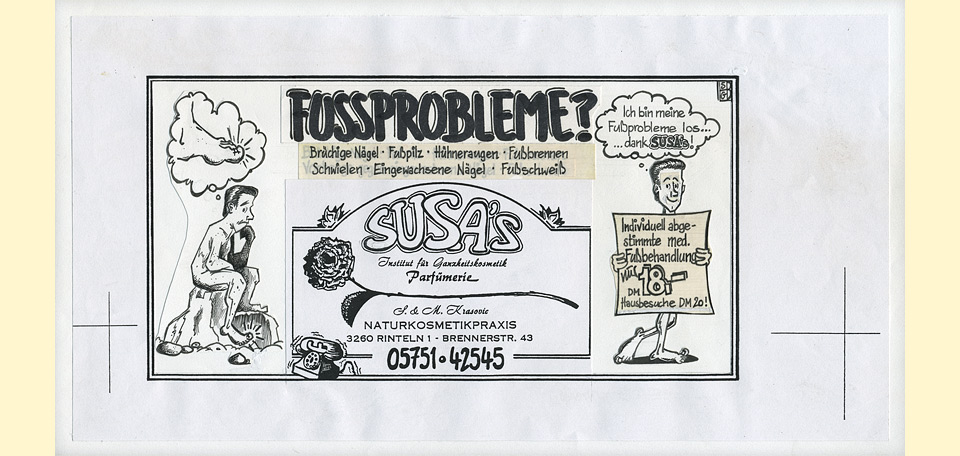
Foot problems? Brittle Nails? Athlete’s Foot? Susa’s Institute for Wholistic Cosmetics has you covered. (Oh, the glamour! “Fuss” is German for “foot,” by the way.)
Along the way, I found out that the ads at the neighborhood movie theater were just regular 35 mm slides. I asked the people at the local camera store if they could turn my drawings into slides. “Yeah, no problem. It’ll take a week, and it’ll cost you $10.” Interesting. I approached my existing clients and asked them if they’d be interested in running my ads at the movies. My first client at the bicycle store told me that a company had already approached him about that, but that just making the slide would cost $200. “What if I can do it for half that?” For the next few years you couldn’t watch a movie in my town without having to sit through a few of my slides. Seeing my work on the big screen was a huge thrill, and I’m glad that I’m occasionally getting that opportunity again these days.
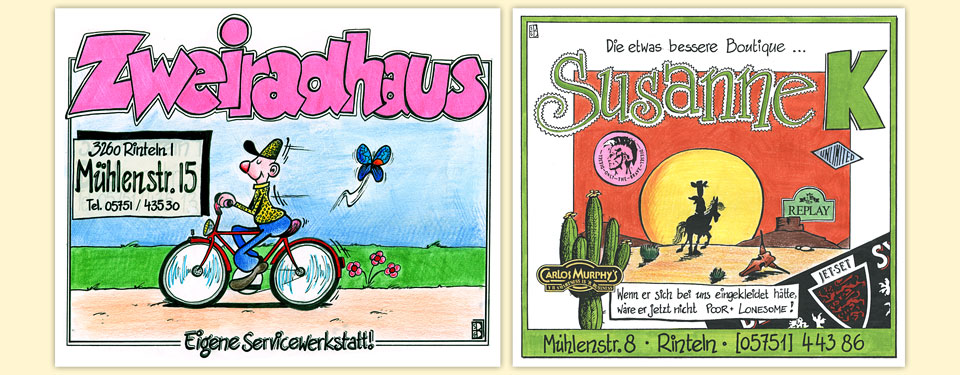
Two of the ads I adapted for use at the local movie theater.
In October of 1990, I met Günther ter Balk, the owner of a pharmacy in a nearby town—the Viktoria Apotheke. This call came to me based on a recommendation from my cartoonist friend Uli, who had also connected me to Glashaus. My dad—who was always wonderfully supportive of my various activities—drove me to meet the man. (Germany wouldn’t give you a driver’s license until your 18th birthday. I had just turned 17.) Herr ter Balk had a particular challenge: German law barred pharmacies (as well as doctors, lawyers and architects) from advertising their services. This was based on the idea that their services are nobler, more solemn, than mere trade, and shouldn’t be hawked. It’s a really good idea, actually, and it does have an impact on the culture at large.
That said, Herr ter Balk still wanted to increase his business, and the law did allow for ads that were seasonal greeting messages. He asked me to pitch him as many holiday ads as I could think of. Christmas, New Year, and Easter were a given. We’d also celebrate the birthday of the pharmacy. And Queen Victoria’s birthday. And Winston Churchill’s birthday. Some of these ads became window displays, too.
We were also allowed to make promotional items. My first piece for the pharmacy was a sticker with a cartoon of Dr. Frankenstein and his Monster. “I made it happen with the sound advice I received at the Viktoria Apotheke.” (It’s just as snappy in German.) This was a round sticker with round type, lettered by hand. It took a lot of fine protractor work, and a lot of trial and error. This was also my first four-color print job, and it fills me with shame to this day. As I’ve said elsewhere, achieving perfectly flat colors was an obsession of mine until I finally got a computer in college. I had had only limited success using color pencils, so I used watercolors for this one. As a sketch. Which got the ideas across, but was splotchy at best. To my horror, the vendor just reproduced the sketch exactly. I had thought that they’d work with me to clean things up. Evidently not. My cheeks still burn at the memory.
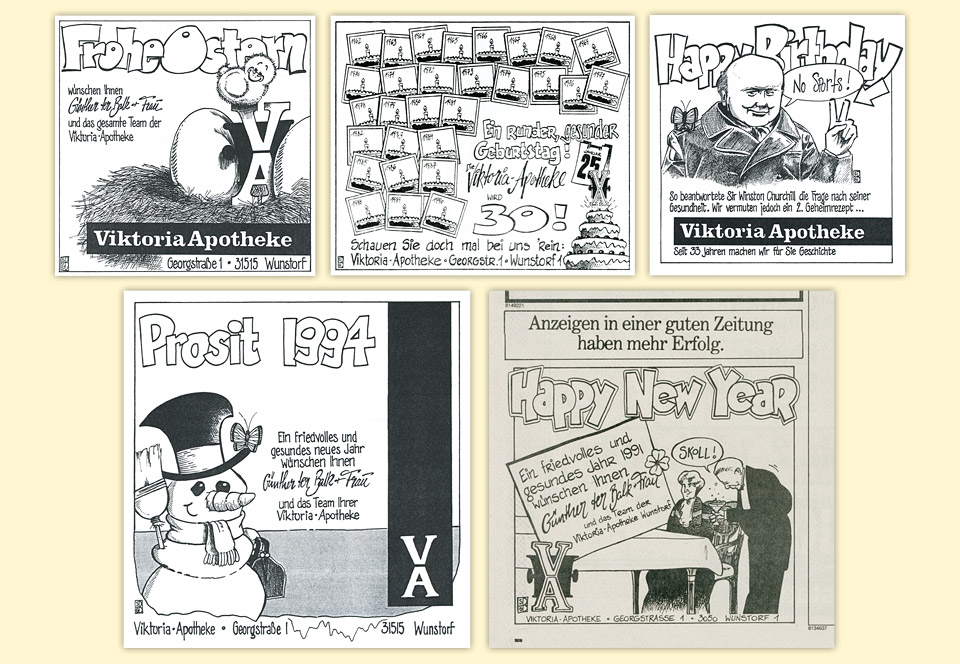
Various ads for the Viktoria pharmacy in Wunstorf, Germany
At the time, it seemed perfectly normal that I was getting all these assignments, and that people were starting to pay me some serious money, too. Looking back now, it’s hard to believe it worked. “Hi. I’m in high school. I draw a lot, and I’d like to take over your advertising, please.” But I was completely convinced that I had it wired. Lately, I’ve tried tracking down my old contacts, but I’ve not had much luck. A lot of the old stores are gone, the Glashaus got bought and sold, and Herr ter Balk passed away. I wish I could thank them for the faith they put in me, and for showing me that you can just imagine a job for yourself.
After I graduated from high school and moved to the United States I tried doing the responsible thing and got myself a real job—working as an art director at Wieden + Kennedy—and it was immediately clear that the compartmentalized nature of an ad agency wasn’t for me. I missed having a hand in all parts of the ads. Luckily, my time as a proper ad man was short, and I’ve been working pretty the same way I did back in the Old Country ever since. The clients are different, but the spirit is the same.
